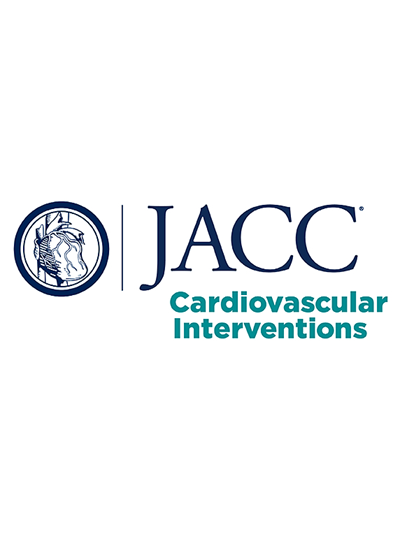治疗原发性主动脉瓣反流的专用经导管设备与标签外经导管设备的 Meta 分析。
IF 11.7
1区 医学
Q1 CARDIAC & CARDIOVASCULAR SYSTEMS
引用次数: 0
摘要
背景:经导管主动脉瓣置换术(TAVR)为严重主动脉瓣反流(AR)的高手术风险患者带来了独特的挑战。JenaValve(JenaValve Technology)和J-Valve(JC Medical Inc)等专用设备在应对这些挑战方面显示出良好的效果:本研究比较了纯原发性 AR 高手术风险患者使用专用器械和非标示器械的安全性和有效性:我们系统地检索了 PubMed、EMBASE 和 Cochrane Central Register of Controlled Trials(截至 2024 年 7 月 11 日的对照试验中央登记册)中有关纯重度原发性 AR 患者 TAVR 的研究。主要终点是 30 天全因死亡率。次要终点为设备成功率、残余 AR ≥ 中度、瓣膜栓塞/移位、起搏器植入、再介入以及 1 年的全因死亡率。采用随机效应模型进行了汇总估算:共有34项研究纳入了荟萃分析,涉及2162名患者(平均年龄为75.4 ± 0.2岁,42.8%为女性)。与标签外设备相比,使用专用设备进行TAVR的患者30天全因死亡率较低(3% vs 9%; P < 0.01),设备成功率较高(93% vs 82%; P < 0.01)。专用装置组的30天AR≥中度(2% vs 5%;P = 0.03)、瓣膜栓塞/移位(2% vs 8%;P < 0.01)、起搏器植入(11% vs 20%;P < 0.01)和再介入(4% vs 10%;P < 0.01)风险以及1年全因死亡率(6% vs 24%;P < 0.01)均较低:结论:与标签外设备相比,治疗原发性 AR 的专用 TAVR 设备显示出更优越的设备成功率,并降低了死亡率、残余 AR 和再介入率。这些研究结果支持使用专用装置作为高风险患者的更安全替代方案。本文章由计算机程序翻译,如有差异,请以英文原文为准。
Meta-Analysis of Dedicated vs Off-Label Transcatheter Devices for Native Aortic Regurgitation
Background
Transcatheter aortic valve replacement (TAVR) for high surgical risk patients with severe native aortic regurgitation (AR) presents unique challenges. Dedicated devices such as the JenaValve (JenaValve Technology) and J-Valve (JC Medical Inc) show promising results in addressing these challenges.
Objectives
This study compares the safety and efficacy of dedicated vs off-label devices among high surgical risk patients with pure native AR.
Methods
We systematically searched PubMed, EMBASE, and Cochrane Central Register of Controlled Trials through July 11, 2024, for studies on TAVR among patients with pure severe native AR. The primary endpoint was 30-day all-cause mortality. Secondary endpoints were device success, residual AR ≥ moderate, valve embolization/migration, pacemaker implantation, reintervention, and all-cause mortality at 1 year. Summary estimates were constructed using a random effects model.
Results
A total of 34 studies encompassing 2,162 patients (mean age 75.4 ± 0.2 years, 42.8% women) were included in the meta-analysis. Patients undergoing TAVR with dedicated devices had a lower all-cause 30-day mortality rate (3% vs 9%; P < 0.01) and higher device success (93% vs 82%; P < 0.01) compared with off-label devices. The risk of AR ≥ moderate (2% vs 5%; P = 0.03), valve embolization/migration (2% vs 8%; P < 0.01), pacemaker implantation (11% vs 20%; P < 0.01), and reintervention (4% vs 10%; P < 0.01) at 30 days and all-cause mortality at 1 year (6% vs 24%; P < 0.01) were lower in the dedicated device group.
Conclusions
Dedicated TAVR devices for native AR show superior device success and reduced mortality, residual AR, and reintervention rates compared with off-label devices. These findings support the use of dedicated devices as a safer alternative for high-risk patients.
求助全文
通过发布文献求助,成功后即可免费获取论文全文。
去求助
来源期刊

JACC. Cardiovascular interventions
CARDIAC & CARDIOVASCULAR SYSTEMS-
CiteScore
11.60
自引率
8.80%
发文量
756
审稿时长
4-8 weeks
期刊介绍:
JACC: Cardiovascular Interventions is a specialist journal launched by the Journal of the American College of Cardiology (JACC). It covers the entire field of interventional cardiovascular medicine, including cardiac, peripheral, and cerebrovascular interventions. The journal publishes studies that will impact the practice of interventional cardiovascular medicine, including clinical trials, experimental studies, and in-depth discussions by respected experts. To enhance visual understanding, the journal is published both in print and electronically, utilizing the latest technologies.
 求助内容:
求助内容: 应助结果提醒方式:
应助结果提醒方式:


